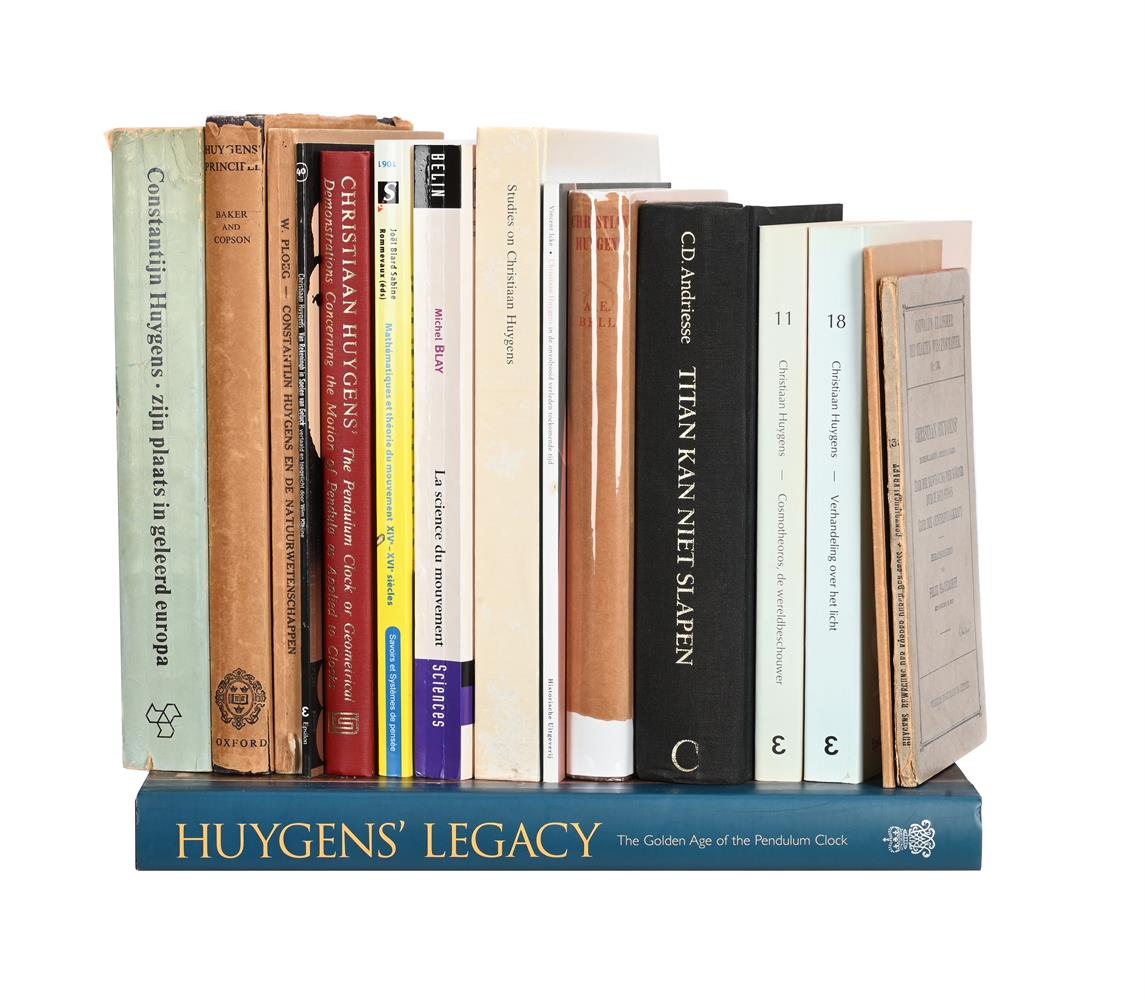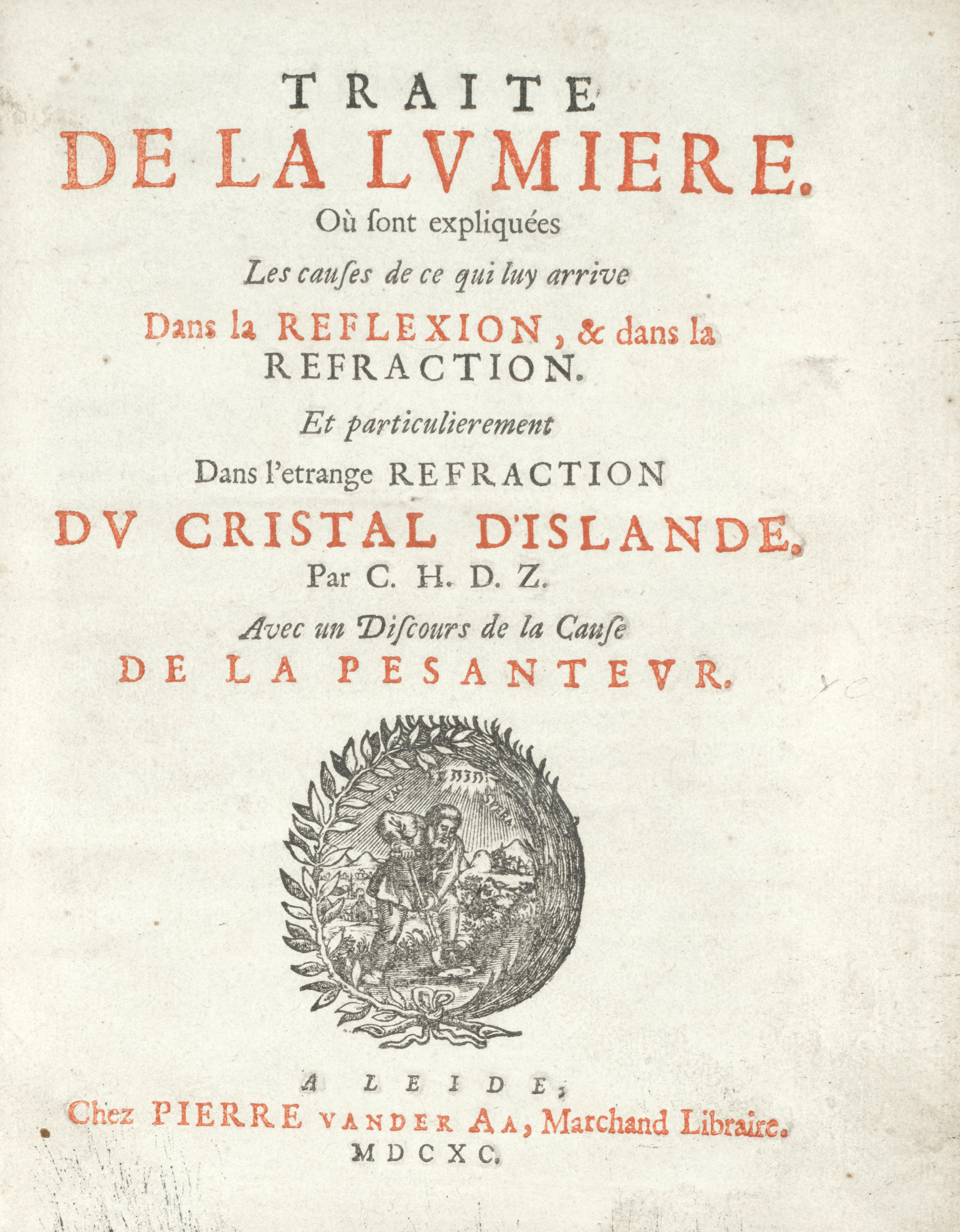HUYGENS, Christiaan (1629-1695). Traité de la lumiere. Ou sont expliquées les causes de ce qui arrive dans la reflexion, & dans la refraction...Avec un discours de la cause de la pesanteur . Leiden: Pieter vander Aa, 1690. 2 parts in one volume (part 2 with a separate title), 4° (202 x 160mm). General title printed in red and black, woodcut device on both titles, 89 woodcut diagrams in the text (a little browned and spotted throughout). Contemporary mottled calf, gilt spine with red morocco lettering piece (joints and corners repaired). Provenance : Lemery (black stamp on an endpaper) -- Jules Viôlle (blue stamp on same endpaper) -- Librairie Thomas-Scheler (label on another endpaper).
HUYGENS, Christiaan (1629-1695). Traité de la lumiere. Ou sont expliquées les causes de ce qui arrive dans la reflexion, & dans la refraction...Avec un discours de la cause de la pesanteur . Leiden: Pieter vander Aa, 1690. 2 parts in one volume (part 2 with a separate title), 4° (202 x 160mm). General title printed in red and black, woodcut device on both titles, 89 woodcut diagrams in the text (a little browned and spotted throughout). Contemporary mottled calf, gilt spine with red morocco lettering piece (joints and corners repaired). Provenance : Lemery (black stamp on an endpaper) -- Jules Viôlle (blue stamp on same endpaper) -- Librairie Thomas-Scheler (label on another endpaper). FIRST EDITION, issue with Huygen's full name on title. Traité de lumiere contains Huygens monumentally important exposition of his wave or pulse theory of light. He had developed his theory in 1676 and 1677 and completed the Traité de la lumière in 1678. In the following year he read portions of it to the Academy, but left it unpublished until Newton's Principia (1687) and a visit to Newton in 1689 stimulated him to have it printed. 'Light, according to Huygens, is an irregular series of shock waves which proceeds with very great, but finite, velocity through the ether. This ether consists of infinitely minute, elastic particles compressed very close together. Light, therefore, is not an actual transference but rather of a 'tendency to move', a serial displacement similar to a collision which proceeds through a row of balls ... Huygens therefore concluded that new wave fronts originate around each particle that is touched by light and extend outward from the particle in the form of hemispheres...', ( DSB ). Huygens was able to explain reflexion and refraction using this theory, of which he became completely convinced on August 6 1677, when he found that it explained the double refraction in Iceland spar. His theory was opposed to the corpuscular theory of light advanced by Newton. In the second part of the work, the Discours de la cause de la pesanteur , written in 1669, Huygens expounded his vortex theory of gravity which also contrasted markedly with Newton's notion of a universal attractional force intrinsic to matter. Indeed, Huygens added to the original treatise of 1669 a review of Newton's theory, rejecting the latter out of hand owing to the impossibility of explaining it by any mechanical principle or law of motion. Huygens' work fell into oblivion in the following century; but his theory of light was confirmed at the beginning of the 19th century by Thomas Young who used it to explain optical interference, and by Jean-Augustin Fresnel a few years later. Modern physics has reconciled Newton's and Huygens' theories in discerning both corpuscular and wave characteristics in the properties of light. Dibner 145; Grolier/Horblit 54; Krivatsy 6124; Norman 1139.
HUYGENS, Christiaan (1629-1695). Traité de la lumiere. Ou sont expliquées les causes de ce qui arrive dans la reflexion, & dans la refraction...Avec un discours de la cause de la pesanteur . Leiden: Pieter vander Aa, 1690. 2 parts in one volume (part 2 with a separate title), 4° (202 x 160mm). General title printed in red and black, woodcut device on both titles, 89 woodcut diagrams in the text (a little browned and spotted throughout). Contemporary mottled calf, gilt spine with red morocco lettering piece (joints and corners repaired). Provenance : Lemery (black stamp on an endpaper) -- Jules Viôlle (blue stamp on same endpaper) -- Librairie Thomas-Scheler (label on another endpaper).
HUYGENS, Christiaan (1629-1695). Traité de la lumiere. Ou sont expliquées les causes de ce qui arrive dans la reflexion, & dans la refraction...Avec un discours de la cause de la pesanteur . Leiden: Pieter vander Aa, 1690. 2 parts in one volume (part 2 with a separate title), 4° (202 x 160mm). General title printed in red and black, woodcut device on both titles, 89 woodcut diagrams in the text (a little browned and spotted throughout). Contemporary mottled calf, gilt spine with red morocco lettering piece (joints and corners repaired). Provenance : Lemery (black stamp on an endpaper) -- Jules Viôlle (blue stamp on same endpaper) -- Librairie Thomas-Scheler (label on another endpaper). FIRST EDITION, issue with Huygen's full name on title. Traité de lumiere contains Huygens monumentally important exposition of his wave or pulse theory of light. He had developed his theory in 1676 and 1677 and completed the Traité de la lumière in 1678. In the following year he read portions of it to the Academy, but left it unpublished until Newton's Principia (1687) and a visit to Newton in 1689 stimulated him to have it printed. 'Light, according to Huygens, is an irregular series of shock waves which proceeds with very great, but finite, velocity through the ether. This ether consists of infinitely minute, elastic particles compressed very close together. Light, therefore, is not an actual transference but rather of a 'tendency to move', a serial displacement similar to a collision which proceeds through a row of balls ... Huygens therefore concluded that new wave fronts originate around each particle that is touched by light and extend outward from the particle in the form of hemispheres...', ( DSB ). Huygens was able to explain reflexion and refraction using this theory, of which he became completely convinced on August 6 1677, when he found that it explained the double refraction in Iceland spar. His theory was opposed to the corpuscular theory of light advanced by Newton. In the second part of the work, the Discours de la cause de la pesanteur , written in 1669, Huygens expounded his vortex theory of gravity which also contrasted markedly with Newton's notion of a universal attractional force intrinsic to matter. Indeed, Huygens added to the original treatise of 1669 a review of Newton's theory, rejecting the latter out of hand owing to the impossibility of explaining it by any mechanical principle or law of motion. Huygens' work fell into oblivion in the following century; but his theory of light was confirmed at the beginning of the 19th century by Thomas Young who used it to explain optical interference, and by Jean-Augustin Fresnel a few years later. Modern physics has reconciled Newton's and Huygens' theories in discerning both corpuscular and wave characteristics in the properties of light. Dibner 145; Grolier/Horblit 54; Krivatsy 6124; Norman 1139.


.jpg?w=400)




.jpg)
.jpg)

.jpg)
.jpg)
.jpg)

Testen Sie LotSearch und seine Premium-Features 7 Tage - ohne Kosten!
Lassen Sie sich automatisch über neue Objekte in kommenden Auktionen benachrichtigen.
Suchauftrag anlegen